Beware of handling hair dryers; you might get burned from ignition or sparks, and your hair might be sucked and caught
Purpose
Hair dryers have been widely spread among general households and commonly used. The number of hair dryers shipped domestically reached 4,940,000 in FY2015. 1
PIO-NET 2 annually received more than 100 inquiries about hair dryers between FY2011 and FY2015. The data contains about 50-70 harmful/hazardous incidents 3 per year (e.g. "I was burned with sparks from the root of the cord", "My hair was sucked and caught in a hair dryer, so I had to cut my hair").
Based on these inquiries, NCAC conducted a questionnaire about use of hair dryers among consumers, a survey on use of hair dryers in general households, and a simulation test on possible damage in the cord as well as suction of hair. Then, NCAC decided to issue an alert and provide information concerned.
- 1 According to a survey by the Japan Electrical Manufacturers' Association
- 2 PIO-NET (Practical Living Information Online-Network System) is a database that collects information on inquiries concerning consumer affairs by linking the National Consumer Affairs Center of Japan with local consumer centers and similar organizations across Japan via an online network.
- 3 "Harmful/hazardous incidents" combine data on products, services, or facilities involved in an incident of harm, i.e. bodily injury and/or sickness or other disease, etc. ("harmful incident data") and cases in which there was the potential for harm, even though no actual harm was suffered ("hazardous incident data").
Test period
Purchase of specimens: September 2016 - October 2016
Test period: September 2016 - November 2016
Outline of hair dryers
(1) Shape of hair dryers
Hair dryers commonly sold are roughly divided into two types: those with a dedicated handle (hereinafter called "normal hair dryers") and those in a cylindrical shape incorporating a brush and a handle (hereinafter called "curling hair dryers"). (See Photo 1)
Photo 1: Common shapes of hair dryers (examples)
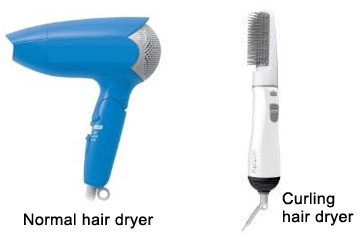
(2) Hair dryer mechanism (example of a normal hair dryer)
A hair dryer contains a fan, a motor, a heater, etc. in its tubular body. Rotation of the fan draws air in from the air inlet. The air is warmed when it passes through the heater, then the warmed air is blown out from the hair dryer. (See Photo 2)
Photo 2: Internal structure of a normal hair dryer (example)
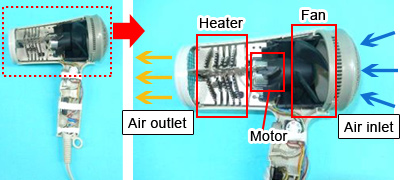
Harmful/hazardous incident data 4
(1) Number of inquiries per fiscal year and breakdown thereof
PIO-NET received 366 inquiries about harmful/hazardous incidents caused by a hair dryer between FY2011 and FY2016 (data registered through October 31, 2016). The number of the inquiries has gradually increased. Among these 366 cases, 305 cases relate to smoking, igniting, sparking, etc. from a hair dryer, which accounted for 80-90% every fiscal year (See Diagram 1). With regard to areas of smoking, igniting, sparking, etc., more than half of the 305 cases (158 cases) occurred at the cord. Hair dryers used in these cases were mostly normal hair dryers (See Diagram 2 & 3).
- 4 A breakdown of each case was specially prepared for this publication, except for the number of harmful/hazardous incidents per fiscal year shown on Diagram 1.
Diagram 1: Number of inquiries about harmful/hazardous incidents caused by a hair dryer per fiscal year
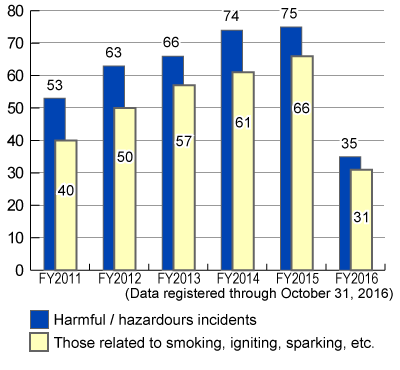
The number of inquiries about harmful/hazardous incidents caused by a hair dryer was 53 in FY2011, 63 in FY2012, 66 in FY2013, 74 in FY2014, 75 in FY2015, and 35 in FY2016. Among them, the number of those related to smoking, igniting, sparking, etc. was 40 in FY2011, 50 in FY2012, 57 in FY2013, 61 in FY2014, 66 in FY2015, and 31 in FY2016.
Diagram 2: Areas of smoking, igniting, sparking, etc
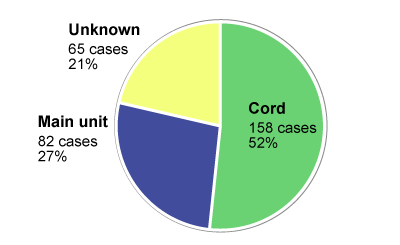
Among incidents of smoking, igniting, sparking, etc. from a hair dryer, 158 cases (52%) occurred at the cord and 82 cases (27%) occurred at the main unit, while 65 cases (21%) were unknown.
Diagram 3: Shapes of hair dryers which smoked, ignited, sparked, etc.
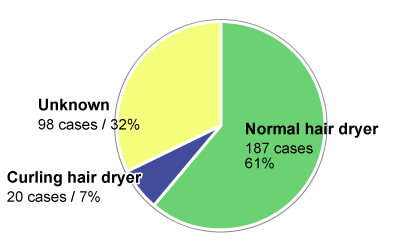
Among hair dryers which smoked, ignited, sparked, etc., 187 dryers (61%) were normal hair dryers and 20 dryers (7%) were curling hair dryers, while 98 cases were unknown.
(2) Cases where respondents got heat burn, got their hair sucked, etc.
Among the 366 harmful/hazardous incidents associated with a hair dryer, harmful incidents amounted to 149. Respondents got heat burn in 105 cases out of the 149 cases. There were other 15 harmful incidents where respondents got their hair sucked into a hair dryer and/or caught, and sometimes their hair got burned. The total of the harmful/hazardous incidents in cases thereof amounted to 22. With regard to harmful/hazardous incidents where respondents got their hairs sucked, all the identified hair dryers were normal type.
Common cases
(1) Cases of heat burn caused by smoking, igniting and sparking from hair dryer's cord
- [Case1]
- When I was using a hair dryer in warm mode, the hair dryer sparked near its main unit. Then the cord was blackened, melted and disconnected. My arm was slightly burned.
- (received in August 2015, inquirer: woman in her 30s in Gunma)
- [Case2]
- When my fourth grader daughter was using a hair dryer, its main unit and the root of its cord shorted out and ignited. She got burned.
- (received in February 2015, inquirer: man in his 40s in Kyoto)
(2) Cases where hair got sucked into a hair dryer
- [Case3]
- When I was using a hair dryer, my 40-50 hairs were sucked into the air inlet. It was unable to draw out the entangled hair from the hair dryer.
- (received in November 2015, inquirer: woman in her 60s in Tokyo)
- [Case4]
- A hair dryer was used more than one year at home. When my daughter was using it, her hair got sucked and caught by the air inlet. The hair dryer became inoperable.
- (received in May 2013, inquirer: man in his 50s in Aichi)
Questionnaire survey
An internet questionnaire was conducted about usage conditions and experience of troubles during use among 1,000 men and 1,000 women aged 15-79 years who routinely use a hair dryer.
(1) How hair dryers are used
About 70% of respondents used a hair dryer almost every day.
With regard to use frequency, about 70% of respondents used a hair dryer almost every day (5-7 days a week). (See Diagram 4)
Diagram 4: Use frequency (n=2000)
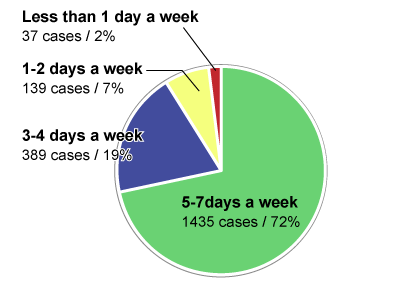
Those who used 5-7 days a week amounted to 1,435 (72%). Those who used 3-4 days a week amounted to 389 (19%). Those who used 1-2 days a week amounted to 139 (7%). Those who used less than one day a week amounted to 37 (2%).
About 60% of respondents did not read the instruction manual.
About 60% of respondents did not read the instruction manual whether or not they kept the manual at home (See Diagram 5).
Diagram 5: Instruction manual (n=2000)
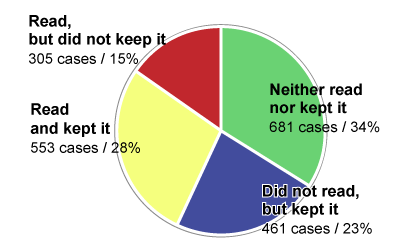
Those who neither read nor kept it amounted to 681 (34%). Those who didn't read but kept it amounted to 461 (23%). Those who read and kept it amounted to 553 (28%). Those who read but did not keep it amounted to 305 (15%).
More than 60% of respondents did not know that the cord should not be looped around the main unit.
When asked about knowledge of precautions in the instruction manual, etc., more than 60% of respondents answered that they did not know that the cord should not be looped around the main unit (See Diagram 6).
Diagram 6: Knowledge of precautions in the instruction manual (n=2000)
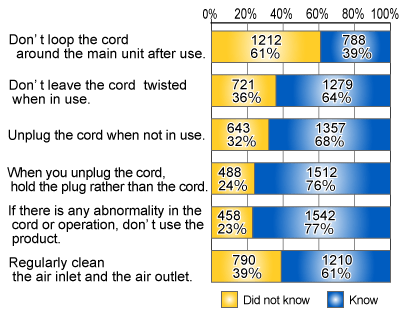
Those who didn't know the precaution "Don't loop the cord around the main unit after use" amounted to 1,212 (61%). Those who didn't know the precaution "Don't leave the cord twisted when in use" amounted to 721 (36%). Those who didn't know the precaution "Unplug the cord when not in use" amounted to 643 (32%). Those who didn't know the precaution "When you unplug the cord, hold the plug rather than the cord" amounted to 488 (24%). Those who didn't know the precaution "If there is any abnormality in the cord or operation, don't use the product" amounted to 458 (23%). Those who didn't know the precaution "Regularly clean the air inlet and the air outlet" amounted to 790 (39%).
Nearly 80% of respondents unplugged a hair dryer after use. Of these respondents, about 30% looped the cord around the main unit.
The instruction manual indicates that the cord should be unplugged after use. When asked about the status of the cord when not in use, nearly 80% of respondents answered that they had unplugged the cord almost every day. Of these respondents, about 30% answered that they had looped the cord around the main unit, which was the most common answer. (See Diagram 7)
Diagram 7: Handling of the cord
How often the cord is unplugged (n=2000)
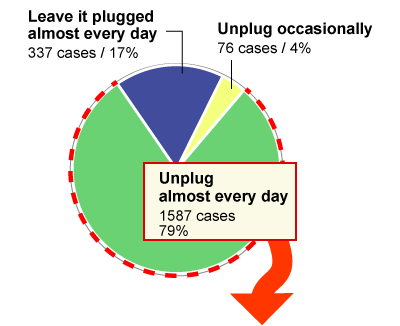
The status of the cord when not in use (n=1587)
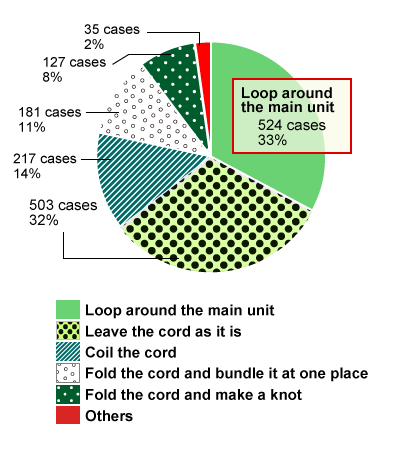
Upper graph:Those who unplugged almost every day amounted to 1,587 (79%). Those who left it plugged almost every day amounted to 337 (17%). Those who unplugged occasionally amounted to 76 (4%).
Lower graph:Those who looped around the main unit amounted to 524 (33%). Those who left the cord as it was amounted to 503 (32%). Those who coiled the cord amounted to 217 (14%). Those who folded the cord and bundled it at one place amounted to 181 (11%). Those who folded the cord and made a knot amounted to 127 (8%). Others amounted to 35 (2%).
(2) Trouble experience during use
When asked about trouble experience during use, 5% of respondents (98 respondents) answered that they had seen smoking, igniting, sparking, etc. from the cord, and 13% of respondents (259 respondents) had got their hair sucked in the air inlet.
Many respondents continued use of a hair dryer even after noticing abnormality in the cord or operation.
NCAC put a question "What did you notice about hair dryer before smoking, igniting, sparking, etc. from the cord?" to 98 respondents who had encountered such incidents. About 70% of them continued use of a hair dryer even after noticing abnormality in the cord or operation, such as "the cord was twisted" (40 respondents), "the cord was partially hotter" (19 respondents), "the coating of the cord was partially discolored" (18 respondents), and "when moving a hair dryer during use, sometimes the air volume changed or the operation stopped" (12 respondents). Incidentally, 26 respondents answered that they had not noticed any abnormality. (See Diagram 8)
Diagram 8: What they noticed before smoking, igniting, sparking, etc. from the cord (n=98: multiple answers allowed)
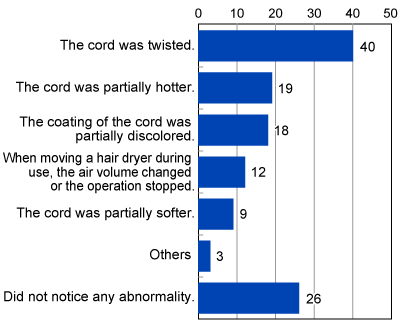
Those who noticed that the cord was twisted amounted to 40. Those who noticed that the cord was partially hotter amounted to 19. Those who noticed that the coating was partially discolored amounted to 18. Those who noticed that when moving a hair dryer during use, the air volume changed or the operation stopped amounted to 12. Those who noticed that the cord was partially softer amounted to 9. Those who noticed other phenomena amounted to 3. Those who didn't notice any abnormality amounted to 26.
Among respondents who had got their hair sucked into a hair dryer, about 50% had got their hair damaged.
NCAC put a question about a subsequent status after hair being sucked into the air inlet to respondents who had experienced such trouble. Those who couldn't draw out their hair from a hair dryer accounted for 16%, and those who got their hair burned or frizzed accounted for 34%. Totally about 50% of them got their hair damaged in any way. (See Diagram 9)
Diagram 9: Damage due to suction of hair (n=259)
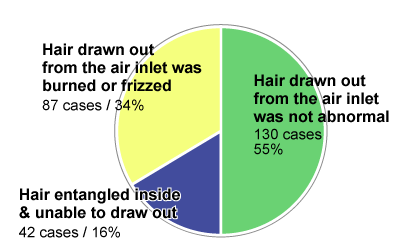
Those who got their hair entangled inside a hair dryer and could not draw out the entangled hair amounted to 42 (16%). Those who drew out their hair from the air inlet but got their hair burned or frizzed amounted to 87 (34%). Those who drew out their hair from the air inlet and didn't find any abnormality in their hair amounted to 130 (50%).
Test results
(1) Survey of hair dryers during use
NCAC collected 47 normal hair dryers being used by consumers to investigate the condition of the cord thereof.
1) Twisting of the cord
Many of the hair dryers had a twisted cord.
As a result of a visual check, it was found out that 41 out of the 47 hair dryers had a twisted cord. Among the 41 hair dryers, some of them had a partially twisted cord which was easily returned to its original state, while the others had a densely and entirely twisted cord which could hardly return to its original state and probably had been used for a long time in such a condition (See Photo 3). The coating and inside conductors of a twisted cord is constantly loaded with tension and curvature, unlike those of a cord in a normal state. If a twisted cord is kept being used, its coating and inside conductors will be prone to deterioration and damage.
Photo 3: Hair dryer's cord which was strongly twisted (example)
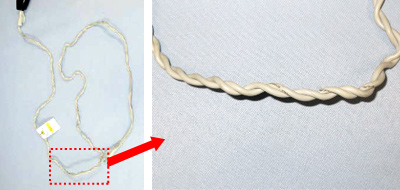
2) Damage of the cord
Local heat on the cord was concentrated around the area of conductor damage.
In the investigation of the cord of the 47 hair dryers with use of X-ray CT, it was found that 4 hair dryers had a conductor which was damaged around the root of the cord. The cord surface of the damaged area was deformed and cracked, and was softer than other areas (See Photo 4). A hair dryer which was most heavily damaged at its conductor was operated to check the surface temperature of the cord around the damaged area with use of thermography. After five minutes, the surface temperature of the cord around the damaged area increased to around 80 centigrade. On the other hand, the surface temperature of the cord in a normal state increased to around 35 centigrade five minutes after the operation, and there was no unevenness in the surface temperature (See Photo 5). The local heat on the cord was generated due to increased electric resistance in the damaged area of the cord (See Diagram 10).
Photo 4: Hair dryer's code damaged in the conductor (example)
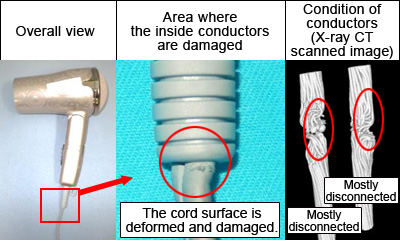
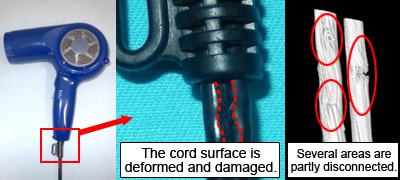
Photo 5: Surface temperature of the cord during operation (thermographic image)
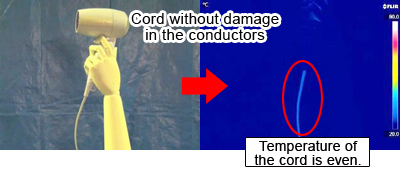
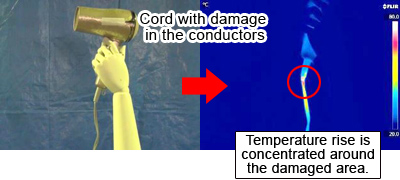
Diagram 10: Local heat on the cord due to partial damage in the conductor
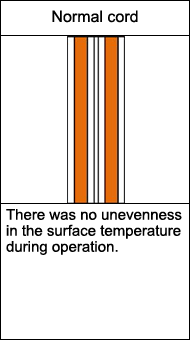
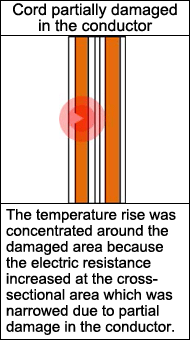
(2) Simulation test
Smoking, igniting, sparking, etc. due to damage of the cord as well as suction of hair into the air inlet were reproduced.
1) Smoking, igniting, sparking from the cord
When a hair dryer damaged in the cord was used, abnormality in operation, smoking, igniting, or sparking was observed.
Smoking, igniting, and sparking due to cord damage were reproduced. In order to simulate the condition of conductor damage, one of the two conductors inside the cord was completely disconnected. When the cord was moved during operation of a hair dryer, the hair dryer intermittently stopped working due to unstable contact between cross sections of the disconnected conductor, and sometimes small sparks were observed. When the two conductors were touched each other to simulate the condition of conductors being shorted out while the coating was widely damaged, big sparks were observed. (See Photo 6 and Diagram 11)
Photo 6: Sparking due to short cords (examples)
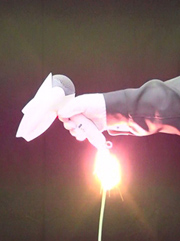
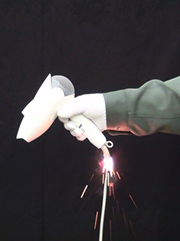
- * Hair dryers in the photo are not related to actual incidents.
Diagram 11: Visualization of how the cord sparks due to damage
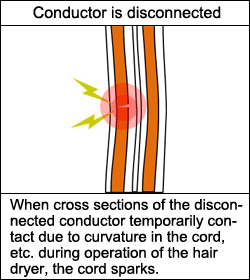
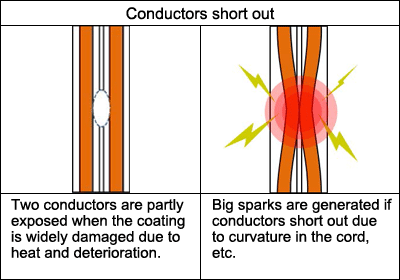
2) Suction of hair
When the tip of hair was near the air inlet, sometimes hair was sucked.
Suction of hair into the air inlet was reproduced with use of artificial hair. When a hair dryer was applied to a shoulder length hair wig, the tip of artificial hair near the air inlet was drawn in and entangled by the internal fan (See Photo 7). When strands of hair were moved close to the air inlet, the artificial hair was drawn in, which stopped rotation of the fan and trapped heated air inside. Smoke was puffing out of the hair dryer. Later, its safety device stopped operation of the hair dryer (See Photo 8).
Photo 7: How artificial hair was drawn into the air inlet (example)
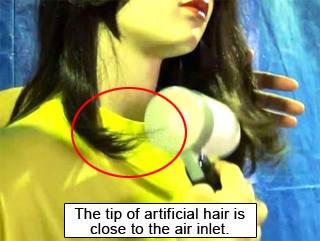
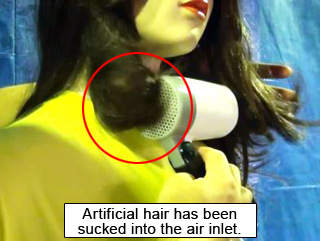
- * Hair dryers in the photo are not related to actual incidents.
Photo 8: Hair dryer has sucked artificial hair and smoked (example)
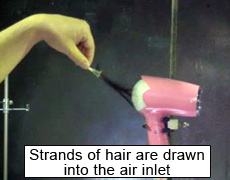
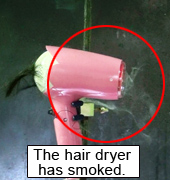
- * Hair dryers in the photo are not related to actual incidents.
(3) If the cord is twisted around the main unit
If the cord is twisted around the main unit, the cord may be damaged.
The questionnaire results show that most of the respondents use a hair dryer almost every day and loop the cord around the main unit after use. If the cord is twisted around the main unit after use, a load is applied to the root of the cord repeatedly, which may damage the cord (See Photo 9).
It is considered that distortion in the cord is generated and accumulated by looping the cord around the main unit, holding and drawing the plug to unwind the cord, or repeatedly changing the manner of holding a hair dryer during use (Photo 10).
Photo 9: Bent part of the cord twisted around a hair dryer (example)
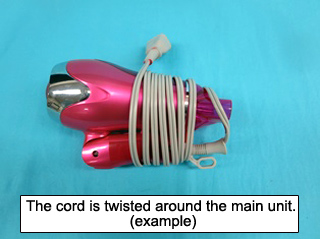
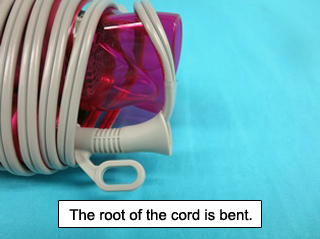
- * Hair dryers in the photo are not related to actual incidents.
Photo 10: Condition which generates distortion in the cord (when twisted around the main unit)
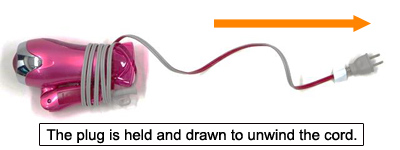

- * Hair dryers in the photo are not related to actual incidents.
- * The half face of the cord is painted to clearly show the twisted state.
(4) Product labeling
Instruction manuals or the product itself indicated precautions such as "In case of abnormality, don't use the product", "Keep the air inlet away from hair", etc.
NCAC checked descriptions on instruction manuals of the normal hair dryers used in the simulation test (8 brands). Instruction manuals of all the brand products indicated precautions such as "Don't loop the cord around the main unit", "If there is any abnormality in the cord or in operation, don't use the product" and "Keep the air inlet away from hair". Some of the brand products had a label pasted on the main unit or a tag attached to the cord indicating precautions (See Diagram 12).
Diagram 12: Examples of hair dryer's precautions (partly excerpted)
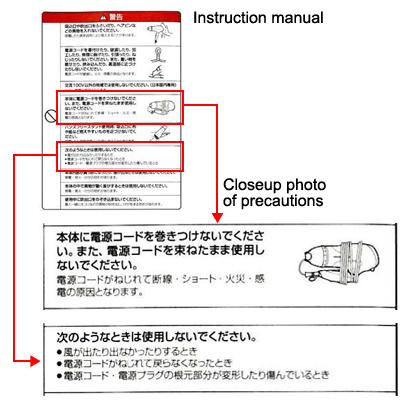
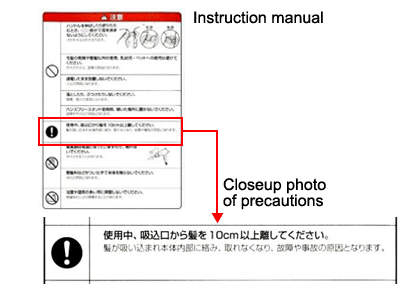
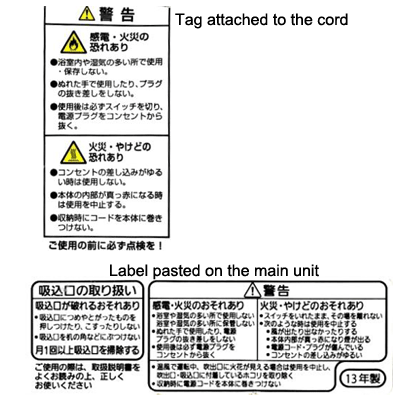
Advice for consumers
(1) Don't loop the cord around the main unit.
The questionnaire results showed that about 30% of the respondents who unplugged a hair dryer after use looped the cord around the main unit and stored the hair dryer. If the cord is twisted around the main unit and kept as it is, a load is repeatedly applied to the cord due to the twisted condition and accumulated distortion, which may cause damage. Therefore, precautions on the instruction manual, etc. indicate not to do so. Heat, smoke, fire, sparks, etc. generated by damage in the cord may cause burns. Be sure not to loop the cord around the main unit.
(2) If there is any abnormality in the cord or operation, stop using the product.
Among respondents who encountered smoking, igniting, sparking, etc. from a hair dryer, about 70% of them kept using the hair dryer even after they noticed any abnormality (e.g. "the cord was twisted", "the cord was partially heated or softened", "the hair dryer stopped working"). After a while, the cord smoked, ignited, sparked, etc. Be sure to stop using a hair dryer if there is any abnormality in the cord or operation. In addition, regularly check if there is any abnormality in the main unit or in the cord.
(3) Keep the air inlet away from the tip of hair.
The questionnaire results showed that about 10% of the respondents had got hair sucked into the air inlet. A normal hair dryer has a built-in fan near the air inlet. Therefore, if the tip of hair is moved close to the air inlet, hair may be accidentally drawn in and entangled by the fan. As a result, hair may get burned or it may become unable to draw hair out. Be sure to keep the air inlet away from hair during use.
(4) Carefully read the instruction manual.
The questionnaire results showed that about 60% of the respondents did not read hair dryer's instruction manual. With regard to precautions, about 60% of the respondents answered that they did not know the safety precaution "Don't loop the cord around the main unit". Even if you know basic usage of the product, carefully read the instruction manual after purchase to properly understand precautions.
Request to businesses
NCAC requests businesses to further improve product safety and raise awareness among consumers in order to prevent troubles during use.
Instruction manuals or other attachment indicate precautions about handling of the cord, suction of hair, etc. On the other hand, the questionnaire results showed that many of the respondents kept using a hair dryer even after noticing abnormality in the cord or operation, and/or looped the cord around the main unit. Some of them had got their hair sucked in the air inlet or had got their hair damaged. In order to prevent such troubles, NCAC requests businesses to further improve product safety and to raise awareness of safe handling of hair dryers among consumers.
